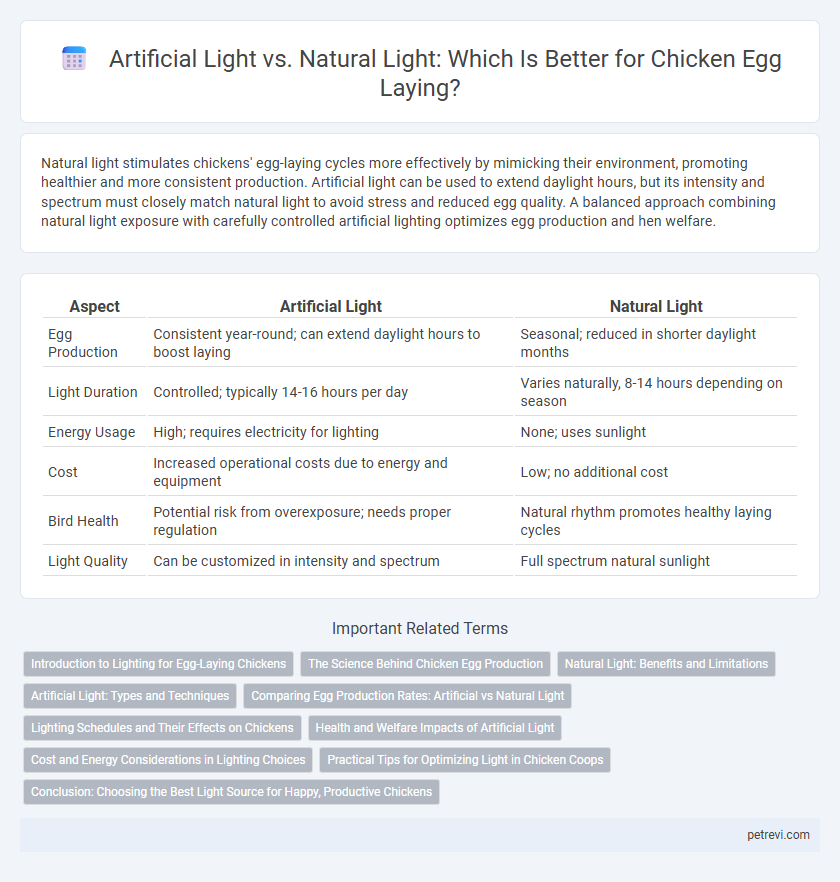Natural light stimulates chickens' egg-laying cycles more effectively by mimicking their environment, promoting healthier and more consistent production. Artificial light can be used to extend daylight hours, but its intensity and spectrum must closely match natural light to avoid stress and reduced egg quality. A balanced approach combining natural light exposure with carefully controlled artificial lighting optimizes egg production and hen welfare.
Table of Comparison
| Aspect | Artificial Light | Natural Light |
|---|---|---|
| Egg Production | Consistent year-round; can extend daylight hours to boost laying | Seasonal; reduced in shorter daylight months |
| Light Duration | Controlled; typically 14-16 hours per day | Varies naturally, 8-14 hours depending on season |
| Energy Usage | High; requires electricity for lighting | None; uses sunlight |
| Cost | Increased operational costs due to energy and equipment | Low; no additional cost |
| Bird Health | Potential risk from overexposure; needs proper regulation | Natural rhythm promotes healthy laying cycles |
| Light Quality | Can be customized in intensity and spectrum | Full spectrum natural sunlight |
Introduction to Lighting for Egg-Laying Chickens
Lighting plays a crucial role in regulating the egg-laying cycles of chickens, with both artificial and natural light influencing their productivity. Natural light provides a full spectrum that supports healthy behavior and hormone regulation, while artificial light allows precise control over photoperiods to extend daylight hours and increase egg production. Optimal lighting for egg-laying chickens typically involves balancing intensity, duration, and wavelength to mimic natural conditions and enhance laying consistency.
The Science Behind Chicken Egg Production
Chicken egg production is influenced by light exposure, with natural light providing a full spectrum that regulates hens' circadian rhythms and stimulates the pineal gland to produce melatonin, essential for reproductive hormone balance. Artificial light, often used in controlled poultry environments, can extend daylight hours to increase laying frequency but lacks the spectral diversity of sunlight, potentially impacting egg quality and hen health. Studies show that replicating natural light cycles and intensity through technological solutions like LED systems enhances egg yield while supporting welfare by mimicking the hens' biological needs.
Natural Light: Benefits and Limitations
Natural light enhances chicken egg laying by supporting circadian rhythms and providing a full spectrum of wavelengths essential for hormone regulation, which boosts productivity and overall health. Exposure to natural light reduces stress and encourages natural behaviors, improving egg quality and hen welfare. However, reliance on natural light can cause seasonal fluctuations in egg production due to shorter daylight hours in winter and unpredictable weather conditions.
Artificial Light: Types and Techniques
Artificial light for chicken egg laying primarily includes LED, fluorescent, and incandescent bulbs, with LED lights being the most energy-efficient and adjustable in spectrum. Techniques such as providing 14-16 hours of consistent light daily simulate longer daylight periods, boosting hens' reproductive cycles and egg production. Timers and dimmers optimize light exposure, ensuring hens receive the appropriate intensity and duration to maximize laying performance.
Comparing Egg Production Rates: Artificial vs Natural Light
Egg production rates in chickens under artificial light often surpass those under natural light due to controlled photoperiods that simulate optimal daylight hours, typically around 14 to 16 hours daily. Natural light varies seasonally and geographically, leading to fluctuating laying patterns and potentially reduced egg output during shorter daylight periods. Studies indicate hens exposed to artificial lighting maintain more consistent and higher egg production compared to those relying solely on natural light cycles.
Lighting Schedules and Their Effects on Chickens
Lighting schedules significantly impact chicken egg production, with natural light providing a balanced spectrum that supports hens' circadian rhythms and overall health. Artificial light allows precise control over photoperiods, commonly extending daily light exposure to 14-16 hours, which stimulates consistent egg laying by mimicking longer daylight conditions. Studies show that combining natural daylight with supplemental artificial lighting optimizes egg production efficiency while reducing stress and improving feed conversion ratios in laying hens.
Health and Welfare Impacts of Artificial Light
Artificial light in chicken egg production can disrupt natural circadian rhythms, leading to increased stress and reduced immune function in hens. Prolonged exposure to artificial light without appropriate dark periods contributes to behavioral issues such as feather pecking and decreased overall welfare. Optimal lighting schedules mimicking natural light cycles improve egg production while supporting hen health and well-being.
Cost and Energy Considerations in Lighting Choices
Artificial lighting in chicken egg production offers controlled photoperiods that can enhance laying frequency but significantly increases energy costs compared to natural sunlight. Natural light, while free and energy-efficient, depends on seasonal and weather variability, potentially reducing egg output during shorter daylight periods. Balancing cost-effectiveness and consistent output often leads producers to optimize light schedules using energy-efficient technologies like LED bulbs to minimize operational expenses.
Practical Tips for Optimizing Light in Chicken Coops
Optimal egg production in chickens depends on consistent lighting schedules that mimic natural daylight, with about 14 to 16 hours of light per day being ideal. Use full-spectrum LED lights designed to replicate natural sunlight wavelengths, positioning them evenly throughout the coop to prevent shadows and stress. Avoid sudden changes in light intensity by gradually increasing or decreasing light duration to maintain hens' circadian rhythms and enhance laying performance.
Conclusion: Choosing the Best Light Source for Happy, Productive Chickens
Natural light supports chickens' circadian rhythms, promoting healthier laying patterns and overall well-being, which can lead to consistent egg production. Artificial light allows for controlled photoperiods that can extend laying periods but must be carefully managed to avoid stress and decreased egg quality. Optimal egg production and chicken welfare are achieved by balancing natural light exposure with strategic artificial lighting tailored to hens' biological needs.
Artificial Light vs Natural Light for Chicken Egg Laying Infographic

 petrevi.com
petrevi.com